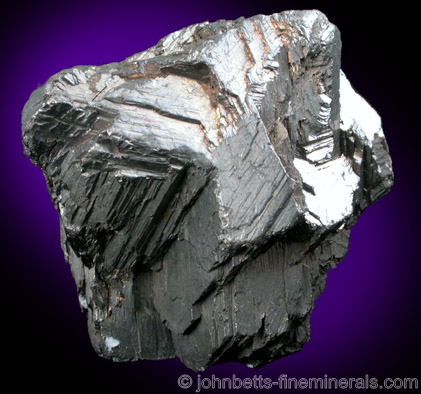The Mineral bismuth

Bismuth is an uncommon mineral composed of the element of the same name. Its rarity is about the same as Silver. It usually forms in ugly masses, though occasionally does form in aesthetic lustrous crystals. Bismuth has a metallic-white color with a slight reddish or pinkish hue. This pure color will only be present on an untarnished (i.e. freshly broken) surface, since Bismuth tarnishes yellow to dark-gray.
Most marketed Bismuth specimens are laboratory grown, and exhibit a very interesting shape. They have hopper-like growths in pseudocubic crystals, and are usually coated with chemicals to prevent tarnish, thus maintaining the silver-white color. Sometimes the coating gives a colorful effect on the bismuth. These artificial crystals are widely available to collectors, and are sometimes not labelled as being lab grown. It is safe to assume that any hopper-shaped crystal with a fine luster and no tarnish is laboratory-grown.
Color
Silver-white, sometimes with reddish hue. Oxidizes yellowish to dark gray.
Properties
Streak
Silver-white |
Hardness
2 - 2.5 |
Transparency
Opaque |
Specific Gravity
9.7 - 9.8 |
Luster
Metallic |
Cleavage
2,1 - prismatic ; 3,1 - basal |
Fracture
Hackly to uneven |
Tenacity
Brittle and slightly sectile |
Other ID Marks
1) Tarnishes yellow to dark gray.
2) Crystals often striated on cleaved surfaces. |
Crystal Habits
Crystals, which are uncommon, are usually flat hexagons occurring in parallel groupings. Also massive and as waterworn nugget in stream beds. Occasionally in feather-like formations of parallel crystals, and rarely in wire habit. Pseudocubic, hopper-like crystal groupings are almost never found in nature, but are laboratory-produced.
Uses
Bismuth is an ore of the element bismuth. lab-grown crystals are widely available in the mineral market.
Bismuth has a unique property where it expands while it solidifies, unlike other matter which contracts. (This same property is exhibited in water). This unique property, and the fact that it is highly diamagnetic, offer it numerous uses in the electronics field.
Noteworthy Localities
Perhaps the best specimens of Bismuth were found in Schneeberg and the surrounding areas in the Erzgebirge in Saxony, Germany. Excellent specimens have also come from St. Ives, Cornwall, England; Wolfram Camp, Dimbulah, Queensland, Australia; and the Siglo Veinte Mine (Llallagua), Potosi, Bolivia. In Canada, Bismuth has been found in and around Cobalt, Timiskaming District, Ontario; and it occurs in Mexico with Bismuthinite at the El Carmen Mine in Durango.
Common Mineral Associations
Bismuthinite, Cassiterite, Quartz
Distingushing Similar Minerals
Antimony, Arsenic - Lower specific gravity and greater hardness.